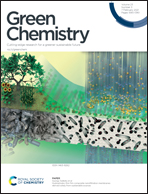s-Tetrazine-functionalized hyper-crosslinked polymers for efficient photocatalytic synthesis of benzimidazoles†
Abstract
Developing green-safe, efficient and recyclable catalysts is crucial for the chemical industry. So far, organic photocatalysis has been proved to be an environmentally friendly and energy-efficient synthetic technology compared with traditional metal catalysis. As a versatile catalytic platform, hyper-crosslinked polymers (HCPs) with large surface area and high stability are easily prepared. In this report, we successfully constructed two porous HCP photocatalysts (TZ-HCPs) featuring s-tetrazine units and surface areas larger than 700 m2 g−1 through Friedel–Crafts alkylation reactions. The rational energy-band structures and coexisting micro- and mesopores endow TZ-HCPs with excellent activities to realize the green synthesis of benzimidazoles (28 examples, up to 99% yield, 0.5–4.0 h) in ethanol. Furthermore, at least 21 iterative catalytic runs mediated by TZ-HCP1D were performed efficiently, with 96–99% yield. This study of TZ-HCPs sheds light on the wide-ranging prospects of application of HCPs as metal-free and green photocatalysts for the preparation of fine chemicals.



 Please wait while we load your content...
Please wait while we load your content...